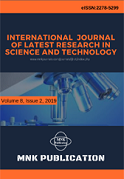DOI:10.29111/ijlrst ISRA Impact Factor:3.35, Peer-reviewed, Open-access Journal
Open Access
International Journal of Latest Research in Science and Technology Vol.9 Issue 1, pp 9-14,Year 2020
Correspondence should be addressed to :
Received : 22 December 2019; Accepted : 20 March 2020 ; Published : 01 April 2020

| Download | 128 |
|---|---|
| View | 184 |
| Article No. | 10986 |
Objectives: The effect of lactose hydrolysis on the rheological and sensory characteristics of frozen yoghurt was investigated during this study. Methods: Yoghurt mix was hydrolyzed by commercial lactase enzyme before the fermentation step. Results: The study revealed that the hydrolyzed samples had slightly shorter fermentation time and higher acidity. Moreover, lactose hydrolysis affected the rheological properties of the frozen yoghurt mix considerably. At shear rate range (2.6- 50 s-1), the maximum apparent viscosity value of hydrolyzed frozen yoghurt mix was 50% less than the regular samples. Similarly, the shear stress value of the hydrolyzed samples was 30% less than the regular samples. Additionally, the hydrolyzed samples showed higher melting rate and significantly lower overrun (39.33±0.732%) compared to (44.63±0.645%) for regular samples. Furthermore, sensory evaluation result showed that creaminess and texture attributes were ranked significantly different (P≤ 0.05). It can be concluded that lactose hydrolysis had a negative impact on some quality attributes and profitability of frozen yoghurt.
Copyright © 2020 J.A.O. Ahmed et al. This is an open access article distributed under the Creative Commons Attribution 4.0 International (CC BY 4.0) license which permits unrestricted use, distribution, and reproduction in any medium, provided the original work is properly cited.
J.A.O. Ahmed, Hala M. Ali and Ibtisam E.M. El Zubeir* , " The Effect Of Lactose Hydrolysis On Rheological, Physical And Sensory Characteristics Of Frozen Yoghurt ", International Journal of Latest Research in Science and Technology . Vol. 9, Issue 1, pp 9-14 , 2020

MNK Publication was founded in 2012 to upholder revolutionary ideas that would advance the research and practice of business and management. Today, we comply with to advance fresh thinking in latest scientific fields where we think we can make a real difference and growth now also including medical and social care, education,management and engineering.

We offers several opportunities for partnership and tie-up with individual, corporate and organizational level. We are working on the open access platform. Editors, authors, readers, librarians and conference organizer can work together. We are giving open opportunities to all. Our team is always willing to work and collaborate to promote open access publication.

Our Journals provide one of the strongest International open access platform for research communities. Our conference proceeding services provide conference organizers a privileged platform for publishing extended conference papers as journal publications. It is deliberated to disseminate scientific research and to establish long term International collaborations and partnerships with academic communities and conference organizers.